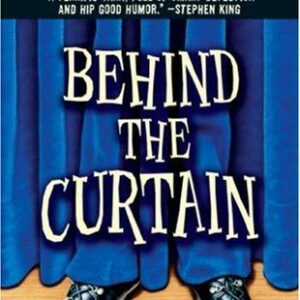Elephants on Acid
$16.99
| Title | Range | Discount |
|---|---|---|
| Trade Discount | 5 + | 25% |
- Description
- Additional information
Description
Alex Boese reveals to readers the results of scores of outrageous, amusing, and provocative experiments found in the files of modern science.
When Tusko the Elephant woke in his pen at the Lincoln Park Zoo on the morning of August 3, 1962, little did he know that he was about to become the test subject in an experiment to determine what happens to an elephant given a massive dose of LSD.
In Elephants on Acid, Boese details the results of this scientific trial, as well as answers to the questions: Why can’t people tickle themselves? Would the average dog summon help in an emergency? Will babies instinctually pick a well-balanced diet? Is it possible to restore life to the dead?
Read on to find out…
When Tusko the Elephant woke in his pen at the Lincoln Park Zoo on the morning of August 3, 1962, little did he know that he was about to become the test subject in an experiment to determine what happens to an elephant given a massive dose of LSD.
In Elephants on Acid, Boese details the results of this scientific trial, as well as answers to the questions: Why can’t people tickle themselves? Would the average dog summon help in an emergency? Will babies instinctually pick a well-balanced diet? Is it possible to restore life to the dead?
Read on to find out…
Alex Boese reveals to readers the results of scores of outrageous, amusing, and provocative experiments found in the files of modern science.
PRAISE FOR HIPPO EATS DWARF
"Do you faithfully follow the commands of every e-mail chain letter? Do you worry about losing your kidneys in a freak robbery/mutilation? Concerned about the tapeworm diet? If you answered ‘yes’ to any of these questions, please check out . . . Hippo Eats Dwarf . . . Learn it. Live it. Don’t ever forward another e-mail chain letter again."—Sacramento Bee
PRAISE FOR MUSEUM OF HOAXES
"As entertaining as it is well researched."—Entertainment Today
"Do you faithfully follow the commands of every e-mail chain letter? Do you worry about losing your kidneys in a freak robbery/mutilation? Concerned about the tapeworm diet? If you answered ‘yes’ to any of these questions, please check out . . . Hippo Eats Dwarf . . . Learn it. Live it. Don’t ever forward another e-mail chain letter again."—Sacramento Bee
PRAISE FOR MUSEUM OF HOAXES
"As entertaining as it is well researched."—Entertainment Today
Recognized as a hoaxpert by CNN and the New York Times, among others, ALEX BOESE holds a master’s degree in the history of science from the University of California, San Diego. He is the author of The Museum of Hoaxes and the creator and curator of www.museumofhoaxes.com.
Chapter One Frankenstein’s lab
Beakers bubble over. Electricity crackles. A man hunches over a laboratory bench, a crazed look in his eyes. This is the classic image of a mad scientist—a pale-skinned, sleep-deprived man toiling away in a lab full of strange machinery, delving into nature’s most forbidden and dreadful secrets. In the popular imagination, no one embodies this image better than Victor Frankenstein, the titular character of Mary Shelley’s 1818 novel. Gathering material from charnel houses and graves, he created an abomination—a living monster pieced together from the body parts of the dead. But he was just fictional, right? Surely no one has done that kind of stuff in real life. Well, perhaps no one has succeeded in creating an undead monster, but it hasn’t been for lack of trying. The history of science is full of researchers whose experiments have, like Frankenstein’s, gone well beyond conventional boundaries of morality and plunged them deep into the realms of the morbid and bizarre. These are the men—for some reason, they are all men—we meet in this chapter. Prepare yourself for zombie kittens, two-headed dogs, and other lab-spawned monstrosities.
The Body Electric “Frog soup,” Madame Galvani wheezed. “Make me some frog soup.” She had been sick in bed for over a week, aching, feverish, and suffering from a wracking cough. The doctor had diagnosed consumption. Frog soup, he assured her, was just the thing to put her on the road to recovery. She asked her servants to prepare some, and soon they were scurrying about, gathering the ingredients. Painfully, she forced herself out of bed to supervise. It was just as well she did so. She found them milling around, searching for somewhere to lay out the frogs. “Put them on the table in my husband’s lab,” Madame Galvani instructed. A servant obediently carried the tray of skinned frogs into the lab and set it down next to one of the doctor’s electrical machines. He picked up a knife and began to carve a frog, but just then a spark flew from the machine and touched the knife. Instantly the legs of the frog twitched and spasmed. Madame Galvani, who had followed the servant in, gasped in surprise. “Luigi, come quick,” she cried. “The most remarkable thing has just happened.” In 1780 Luigi Galvani, an Italian professor of anatomy, discovered that a spark of electricity could cause the limbs of a dead frog to move. Nineteenth-century popularizersof science would later attribute this discovery to his wife’s desire for frog soup. Unfortunately, that part of the story is a legend. The reality is that Galvani was quite purposefully studying frogs, to understand how their muscles contracted, when a spark caused movement in a limb. However, the frog-soup story does have the virtue of restoring to his wife a greater role in the discovery than Galvani granted her—credit she probably deserves since she was a highly educated woman from a family of scientists. And Madame Galvani did develop consumption, and may well have been treated with frog soup. Unfortunately, the frog soup didn’t help her. She died in 1790.
A year after his wife’s death, Galvani finally published an account of the experiment. It caused a sensation throughout Europe. Many believed Galvani had discovered the hidden secret of life. Other men of science rushed to repeat the experiment, but it didn’t take them long to grow bored with frogs and turn their attention to more interesting animals. What would happen, they wondered, if you wired up a human corpse? Galvani’s nephew, Giovanni Aldini, took the initiative and pioneered the art of corpse reanimation. He promoted his publicity-shy uncle’s work by embarking on a tour of Europe in which he offered audiences the greatest (or, at least, most stomach-wrenching) show they’d ever seen—the electrification of a human body.
Aldini’s most celebrated demonstration occurred in London on January 17, 1803, before an audience of the Royal College of Surgeons. The body of twenty-six-year-old George Forster, executed for the murder of his wife and child, was whisked straight from the gallows to Aldini and his waiting crowd. Aldini then attached parts of Forster’s body to the poles of a 120-plate copper-and-zinc battery.
First the face. Aldini placed wires on the mouth and ear. The jaw muscles quivered, and the murderer’s features twisted in a rictus of pain. The left eye opened as if to gaze upon his torturer. Aldini played the body like a marionette, moving wires from one body part to another, making the back arch, the arms beat the table, and the lungs breathe in and out. For the grand finale he hooked one wire to the ear and plunged the other up the rectum. Forster’s corpse broke into a hideous dance. The London Times wrote of the scene: “The right hand was raised and clenched, and the legs and thighs were set in motion. It appeared to the uninformed part of the bystanders as if the wretched man was on the eve of being restored to life.”
A few days later Aldini continued his London tour with a show at a Dr. Pearson’s lecture room. There he unveiled the decapitated head of an ox and extended its tongue out of its mouth by means of a hook. Then he turned on the current. The tongue retracted so rapidly that it tore itself off the hook, while simultaneously “a loud noise issued from the mouth by the absorption of air, attended by violent contortions of the whole head and eyes.” Science had at last created an electric belching ox head.
An even more spectacular demonstration occurred on November 4, 1818, in Glasgow, when Scottish chemist (and later industrial capitalist) Andrew Ure connected the corpse of the executed murderer Matthew Clydesdale to a massive 270-plate battery. Twice the power, twice the fun. When he linked the spinal marrow to the sciatic nerve, “every muscle in the body was immediately agitated with convulsive movements, resembling a violent shuddering from cold.” Connecting the phrenic nerve to the diaphragm provoked “full, nay, laborious breathing . . . The chest heaved, and fell; the belly was protruded, and again collapsed, with the relaxing and retiring diaphragm.” Finally Ure joined the poles of the battery to an exposed nerve in the forehead and to the heel: “Every muscle in his countenance was simultaneously thrown into fearful action; rage, horror, despair, anguish, and ghastly smiles, united their hideous expression in the murderer’s face, surpassing far the wildest represenations of a Fuseli or a Kean.” Some spectators fainted, and others fled the lecture hall in terror.
Men of science such as Aldini and Ure were confident galvanic electricity could do far more than provide a macabre puppet show. They promised that, under the right circumstances, it could restore life itself. Ure wrote of his experiment on the murderer Clydesdale, “There is a probability that life might have been restored. This event, however little desirable with a murderer, and perhaps contrary to law, would yet have been pardonable in one instance, as it would have been highly honourable and useful to science.”
As late as the 1840s, English physicist William Sturgeon (inventor of the first electromagnets) described electrifying the bodies of four drowned young men in an attempt to bring them back to life. He failed but felt sure he would have succeeded had he only reached the scene sooner.
Mary Shelley never indicated on whom she had based her character of Victor Frankenstein, but the experimental electrification of corpses was undeniably a source of inspiration for her. In the introduction to the 1831 edition of Frankenstein, she wrote that the idea for the novel came to her in June 1816, after she overheard Lord Byron and Percy Shelley discussing recent galvanic experiments and speculating about the possibility that electricity could restore life to inanimate matter. That night she had a nightmare about a “pale student of unhallowed arts kneeling beside the thing he had put together. I saw the hideous phantasm of a man stretched out, and then, on the working of some powerful engine, show signs of life, and stir with an uneasy, half-vital motion.” And so, from a journey of discovery that began with a twitching frog, Victor Frankenstein and his monster were born.
Aldini, G. (1803). An account of the galvanic experiments performed by John Aldini, . . . on the body of a malefactor executed at Newgate, Jan. 17, 1803. With a short view of some experiments which will be described in the author’s new work now in the press. London: Cuthell and Martin.
Copyright © 2007 by Alex Boese
All rights reserved. No part of this publication may be reproduced or transmitted in any form or by any means, electronic or mechanical, including photocopy, recording, or any information storage and retrieval system, without permission in writing from the publisher.
Requests for permission to make copies of any part of the work should be submitted online at www.harcourt.com/contact or mailed to the following address: Permissions Department, Harcourt, Inc., 6277 Sea Harbor Drive, Orlando, Florida 32887-6777.
Beakers bubble over. Electricity crackles. A man hunches over a laboratory bench, a crazed look in his eyes. This is the classic image of a mad scientist—a pale-skinned, sleep-deprived man toiling away in a lab full of strange machinery, delving into nature’s most forbidden and dreadful secrets. In the popular imagination, no one embodies this image better than Victor Frankenstein, the titular character of Mary Shelley’s 1818 novel. Gathering material from charnel houses and graves, he created an abomination—a living monster pieced together from the body parts of the dead. But he was just fictional, right? Surely no one has done that kind of stuff in real life. Well, perhaps no one has succeeded in creating an undead monster, but it hasn’t been for lack of trying. The history of science is full of researchers whose experiments have, like Frankenstein’s, gone well beyond conventional boundaries of morality and plunged them deep into the realms of the morbid and bizarre. These are the men—for some reason, they are all men—we meet in this chapter. Prepare yourself for zombie kittens, two-headed dogs, and other lab-spawned monstrosities.
The Body Electric “Frog soup,” Madame Galvani wheezed. “Make me some frog soup.” She had been sick in bed for over a week, aching, feverish, and suffering from a wracking cough. The doctor had diagnosed consumption. Frog soup, he assured her, was just the thing to put her on the road to recovery. She asked her servants to prepare some, and soon they were scurrying about, gathering the ingredients. Painfully, she forced herself out of bed to supervise. It was just as well she did so. She found them milling around, searching for somewhere to lay out the frogs. “Put them on the table in my husband’s lab,” Madame Galvani instructed. A servant obediently carried the tray of skinned frogs into the lab and set it down next to one of the doctor’s electrical machines. He picked up a knife and began to carve a frog, but just then a spark flew from the machine and touched the knife. Instantly the legs of the frog twitched and spasmed. Madame Galvani, who had followed the servant in, gasped in surprise. “Luigi, come quick,” she cried. “The most remarkable thing has just happened.” In 1780 Luigi Galvani, an Italian professor of anatomy, discovered that a spark of electricity could cause the limbs of a dead frog to move. Nineteenth-century popularizersof science would later attribute this discovery to his wife’s desire for frog soup. Unfortunately, that part of the story is a legend. The reality is that Galvani was quite purposefully studying frogs, to understand how their muscles contracted, when a spark caused movement in a limb. However, the frog-soup story does have the virtue of restoring to his wife a greater role in the discovery than Galvani granted her—credit she probably deserves since she was a highly educated woman from a family of scientists. And Madame Galvani did develop consumption, and may well have been treated with frog soup. Unfortunately, the frog soup didn’t help her. She died in 1790.
A year after his wife’s death, Galvani finally published an account of the experiment. It caused a sensation throughout Europe. Many believed Galvani had discovered the hidden secret of life. Other men of science rushed to repeat the experiment, but it didn’t take them long to grow bored with frogs and turn their attention to more interesting animals. What would happen, they wondered, if you wired up a human corpse? Galvani’s nephew, Giovanni Aldini, took the initiative and pioneered the art of corpse reanimation. He promoted his publicity-shy uncle’s work by embarking on a tour of Europe in which he offered audiences the greatest (or, at least, most stomach-wrenching) show they’d ever seen—the electrification of a human body.
Aldini’s most celebrated demonstration occurred in London on January 17, 1803, before an audience of the Royal College of Surgeons. The body of twenty-six-year-old George Forster, executed for the murder of his wife and child, was whisked straight from the gallows to Aldini and his waiting crowd. Aldini then attached parts of Forster’s body to the poles of a 120-plate copper-and-zinc battery.
First the face. Aldini placed wires on the mouth and ear. The jaw muscles quivered, and the murderer’s features twisted in a rictus of pain. The left eye opened as if to gaze upon his torturer. Aldini played the body like a marionette, moving wires from one body part to another, making the back arch, the arms beat the table, and the lungs breathe in and out. For the grand finale he hooked one wire to the ear and plunged the other up the rectum. Forster’s corpse broke into a hideous dance. The London Times wrote of the scene: “The right hand was raised and clenched, and the legs and thighs were set in motion. It appeared to the uninformed part of the bystanders as if the wretched man was on the eve of being restored to life.”
A few days later Aldini continued his London tour with a show at a Dr. Pearson’s lecture room. There he unveiled the decapitated head of an ox and extended its tongue out of its mouth by means of a hook. Then he turned on the current. The tongue retracted so rapidly that it tore itself off the hook, while simultaneously “a loud noise issued from the mouth by the absorption of air, attended by violent contortions of the whole head and eyes.” Science had at last created an electric belching ox head.
An even more spectacular demonstration occurred on November 4, 1818, in Glasgow, when Scottish chemist (and later industrial capitalist) Andrew Ure connected the corpse of the executed murderer Matthew Clydesdale to a massive 270-plate battery. Twice the power, twice the fun. When he linked the spinal marrow to the sciatic nerve, “every muscle in the body was immediately agitated with convulsive movements, resembling a violent shuddering from cold.” Connecting the phrenic nerve to the diaphragm provoked “full, nay, laborious breathing . . . The chest heaved, and fell; the belly was protruded, and again collapsed, with the relaxing and retiring diaphragm.” Finally Ure joined the poles of the battery to an exposed nerve in the forehead and to the heel: “Every muscle in his countenance was simultaneously thrown into fearful action; rage, horror, despair, anguish, and ghastly smiles, united their hideous expression in the murderer’s face, surpassing far the wildest represenations of a Fuseli or a Kean.” Some spectators fainted, and others fled the lecture hall in terror.
Men of science such as Aldini and Ure were confident galvanic electricity could do far more than provide a macabre puppet show. They promised that, under the right circumstances, it could restore life itself. Ure wrote of his experiment on the murderer Clydesdale, “There is a probability that life might have been restored. This event, however little desirable with a murderer, and perhaps contrary to law, would yet have been pardonable in one instance, as it would have been highly honourable and useful to science.”
As late as the 1840s, English physicist William Sturgeon (inventor of the first electromagnets) described electrifying the bodies of four drowned young men in an attempt to bring them back to life. He failed but felt sure he would have succeeded had he only reached the scene sooner.
Mary Shelley never indicated on whom she had based her character of Victor Frankenstein, but the experimental electrification of corpses was undeniably a source of inspiration for her. In the introduction to the 1831 edition of Frankenstein, she wrote that the idea for the novel came to her in June 1816, after she overheard Lord Byron and Percy Shelley discussing recent galvanic experiments and speculating about the possibility that electricity could restore life to inanimate matter. That night she had a nightmare about a “pale student of unhallowed arts kneeling beside the thing he had put together. I saw the hideous phantasm of a man stretched out, and then, on the working of some powerful engine, show signs of life, and stir with an uneasy, half-vital motion.” And so, from a journey of discovery that began with a twitching frog, Victor Frankenstein and his monster were born.
Aldini, G. (1803). An account of the galvanic experiments performed by John Aldini, . . . on the body of a malefactor executed at Newgate, Jan. 17, 1803. With a short view of some experiments which will be described in the author’s new work now in the press. London: Cuthell and Martin.
Copyright © 2007 by Alex Boese
All rights reserved. No part of this publication may be reproduced or transmitted in any form or by any means, electronic or mechanical, including photocopy, recording, or any information storage and retrieval system, without permission in writing from the publisher.
Requests for permission to make copies of any part of the work should be submitted online at www.harcourt.com/contact or mailed to the following address: Permissions Department, Harcourt, Inc., 6277 Sea Harbor Drive, Orlando, Florida 32887-6777.
Contents
Introduction ix
1. Frankenstein’s Lab
2. Sensorama 29
3. Total Recall 58
4. Bedtime Stories 85
5. Animal Tales 108
6. Mating Behavior 136
7. Oh, Baby! 163
8. Bathroom Reading 1949. Making Mr. Hyde 210
10. The End 241
Acknowledgments 267
References 268
Photo and Illustration Credits 279
Index 281
Introduction ix
1. Frankenstein’s Lab
2. Sensorama 29
3. Total Recall 58
4. Bedtime Stories 85
5. Animal Tales 108
6. Mating Behavior 136
7. Oh, Baby! 163
8. Bathroom Reading 1949. Making Mr. Hyde 210
10. The End 241
Acknowledgments 267
References 268
Photo and Illustration Credits 279
Index 281
Additional information
| Weight | 1 oz |
|---|---|
| Dimensions | 1 × 5 × 8 in |











